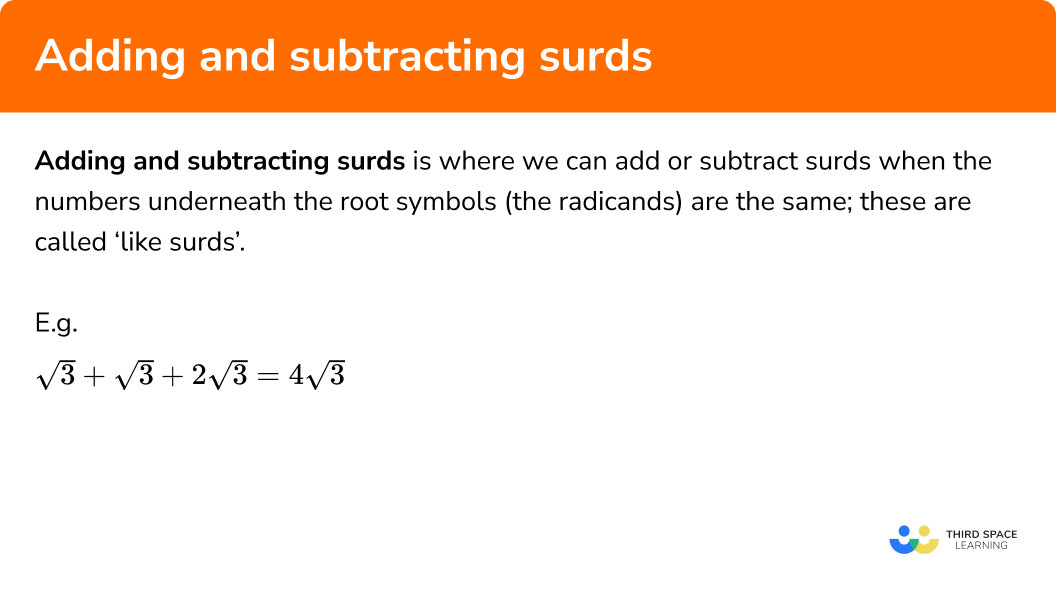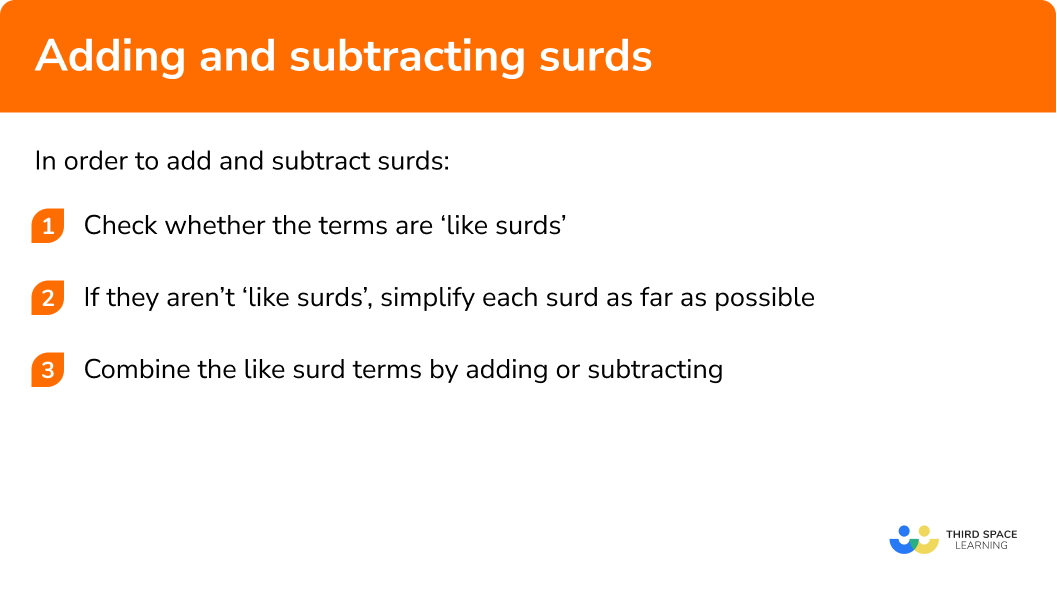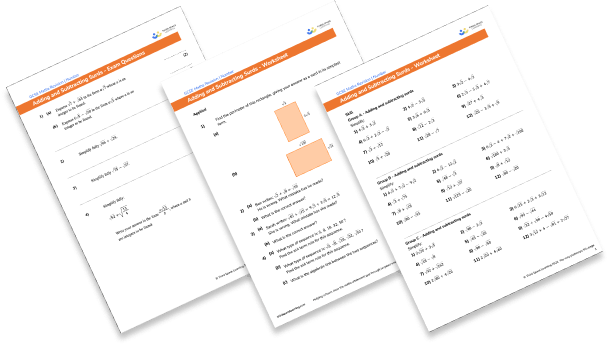One to one maths interventions built for KS4 success
Weekly online one to one GCSE maths revision lessons now available
In order to access this I need to be confident with:
Squares and square roots Simplifying surds Multiplying and dividing surdsThis topic is relevant for:

Adding And Subtracting Surds
Here we will learn about adding and subtracting surds including when surd expressions can be added or subtracted, and how to carry out these calculations.
There are also adding and subtracting surds worksheets based on Edexcel, AQA and OCR exam questions, along with further guidance on where to go next if you’re still stuck.
What is adding and subtracting surds?
Adding and subtracting surds is where we can add or subtract surds when the numbers underneath the root symbols (the radicands) are the same; these are called ‘like surds’.
This is similar to collecting like terms in algebra:
E.g.
So when we do a similar thing with surds:
E.g.
And just as
2\sqrt{3}+3\sqrt{7} cannot be simplified because the numbers underneath the square root symbols (radicands) are different. \sqrt{3} and \sqrt{7} are not ‘like surds’.
If surds can be simplified so that they are ‘like surds’, then they can be added or subtracted.
You may be asked to apply these skills at GCSE maths to give answers to problems in geometry, such as Pythagoras or trigonometry, as exact values, rather than as decimals. Before calculators were invented, surds were the standard form for stating answers which were irrational numbers.
The formula for solving quadratics also uses a square root sign, so you may need to apply your knowledge of surds here as well.
What is adding and subtracting surds?

How to add and subtract surds
In order to add and subtract surds:
- Check whether the terms are ‘like surds’.
- If they aren’t like surds, simplify each surd as far as possible.
- Combine the like surd terms by adding or subtracting.
How to add and subtract surds


Adding and subtracting surds worksheet

Get your free adding and subtracting surds worksheet of 20+ questions and answers. Includes reasoning and applied questions.
DOWNLOAD FREE
Adding and subtracting surds worksheet

Get your free adding and subtracting surds worksheet of 20+ questions and answers. Includes reasoning and applied questions.
DOWNLOAD FREEAdding and subtracting surds examples
Example 1: like surds, simple addition
Simplify
- Check whether the terms are ‘like surds’.
The number under the root sign is already
2If they aren’t like surds, simplify each surd as far as possible.
We don’t need to change the surd terms in this question.
3Combine the like surd terms by adding or subtracting.
so,
Example 2: like surds, simple subtractions
Simplify
Check whether the terms are ‘like surds’.
The number under the root sign is already
If they aren’t like surds, simplify each surd as far as possible.
We don’t need to change the surd terms in this question.
Combine the like surd terms by adding or subtracting.
so,
Example 3: unlike surds
Simplify
Check whether the terms are ‘like surds’.
The numbers under the root signs are
If they aren’t like surds, simplify each surd as far as possible.
These surds cannot be simplified further. There are no square factors of either
Combine the like surd terms by adding or subtracting.
In this case, the surds are not like, so they cannot be combined.
We state the answer as:
Example 4: sums containing non-surds
Simplify
Check whether the terms are ‘like surds’.
All the surd terms are like surds – they are all root
If they aren’t like surds, simplify each surd as far as possible.
We don’t need to simplify the surds.
However, the square root of
Combine the like surd terms by adding or subtracting.
Combining the surds:
We also combine the other like terms – in this case, the integers:
So the final answer is:
Note that it’s always best to start an answer with a positive term, but:
is also correct.
Example 5: one surd needs to be simplified
Simplify
Check whether the terms are ‘like surds’.
The numbers under the root signs are
If they aren’t like surds, simplify each surd as far as possible.
is already fully simplified; there are no square factors of
can be simplified, because
Combine the like surd terms by adding or subtracting.
Example 6: both surds need to be simplified
Simplify
Check whether the terms are ‘like surds’.
The numbers under the root signs are
If they aren’t like surds, simplify each surd as far as possible.
can be simplified, because
can be simplified, because
Note that you could have simplified in stages, using the square factors
Then the surds would not be ‘like’ and you would not be able to combine by addition or subtraction.
Combine the like surd terms by adding or subtracting.
Example 7: two surds need to be simplified
Simplify
Check whether the terms are ‘like surds’.
The numbers under the root signs are
If they aren’t like surds, simplify each surd as far as possible.
can be simplified, because
can be simplified, because
Combine the like surd terms by adding or subtracting.
Even when simplified fully, the surds are not like, so they cannot be combined.
We state the answer as:
Example 8: a sum containing non-surds
Simplify
Check whether the terms are ‘like surds’.
The numbers under the root signs are
If they aren’t like surds, simplify each surd as far as possible.
can be simplified, because
Combine the like surd terms by adding or subtracting.
Common misconceptions
- Remember that a root with no integer coefficient is ‘1 lot’ of that surd
As in algebra, we understand that
- Don’t mix up addition and multiplication laws
Refer back to knowledge of algebra to help:
- Not simplifying each surd fully
As in example
- Trying to combine unlike surds
It’s OK to leave an answer with more than one surd in it if it will not simplify further.
Related lessons
Adding and subtracting surds is part of our series of lessons to support revision on surds. You may find it helpful to start with the main surds lesson for a summary of what to expect, or use the step by step guides below for further detail on individual topics. Other lessons in this series include:
Practice adding and subtracting surds questions
1. Simplify:
3 \sqrt{11}+2 \sqrt{11}-\sqrt{11}




Already in like surd form; 3+2-1=4 .
2. Simplify:
3\sqrt{5}-2\sqrt{3}+4\sqrt{3}




We can only collect the ‘like’ root 3 s; 4-2=2 .
3. Simplify:
\sqrt{11}+\sqrt{44}




4 is a square factor of 44 , so use this to simplify root 44 . There’s then a like surd of root 11 .
4. Simplify:
\sqrt{54}-\sqrt{24}




9 is a square factor of 54 and 4 is a square factor of 24 . When you simplify both roots, there’s a like surd of root 6 .
5. Simplify:
3\sqrt{20}-\sqrt{50}




When both surds are fully simplified, they are not like surds. We just write the answer as the subtraction with simplified surds.
6. Simplify:
3 \sqrt{16}+\sqrt{50}-\sqrt{8}




Root 16 is not a surd, so we work out 3\times4=12 . Then, looking at the surds, when both are simplified, there is a like surd of root 2 . We combine these two surds.
Adding and subtracting surds GCSE questions
1. Express \sqrt{6}+\sqrt{54} in the form a \sqrt{6} where a is an integer.
(2 marks)
\sqrt{54}=\sqrt{9} \times \sqrt{6}
(1)
\sqrt{6} + \sqrt{54} =4\sqrt{6} (a=4)
(1)
2. Simplify fully \sqrt{32}+\sqrt{2}
(2 marks)
\sqrt{32}=\sqrt{16} \times \sqrt{2}
(1)
5 \sqrt{2}
(1)
3. Write \sqrt{40}+\sqrt{160} in the form a \sqrt{10}
(3 marks)
\sqrt{40}=\sqrt{4} \times \sqrt{10}
(1)
\sqrt{160}=\sqrt{16} \times \sqrt{10}
(1)
\sqrt{40} + \sqrt{160} =6\sqrt{10} (a=6)
(1)
Learning checklist
You have now learned how to:
- Add and subtract surds
Still stuck?
Prepare your KS4 students for maths GCSEs success with Third Space Learning. Weekly online one to one GCSE maths revision lessons delivered by expert maths tutors.

Find out more about our GCSE maths tuition programme.